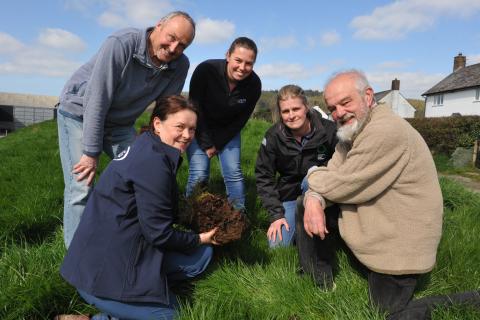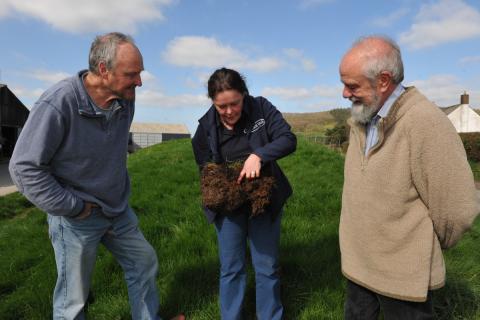18 April 2019
Welsh farmers are being warned to take soil health seriously or risk poor production as spells of extreme wet and dry weather become commonplace.
Fields with poor soil structure won’t perform in very dry conditions because they can’t absorb and then retain moisture during wetter periods, says NIAB soil scientist Dr Elizabeth Stockdale.
Soils with good structure have a mix of big and small ‘pores’ for moving and retaining water, she told farmers attending a joint Farming Connect and AHDB ‘All Things Soils’ event at Trawscoed Farm, a Farming Connect Innovation Site near Aberystwyth.
“The bigger pores, what I call the ‘motorway pores’, may be no bigger than a human hair but are very important for moving water through soils,’’ said Dr Stockdale.
“The network of little pores, the ‘B roads’, are where water is stored and are where plants draw water from in dry periods.’’
This pore network is disrupted in compacted soils or those where low pH limits biological activity.
To establish the condition of soil Dr Stockdale recommends digging a out a spade-sized block of soil.
To ensure no opportunities are missed, she suggests that farmers carry a spade in every vehicle they use.
Score the whole block to a depth of 30cm using the ‘Healthy Grassland Soils’ assessment tool freely available from AHDB. This document provides a pictorial guide to assessing soils in a grassland situation.
“Always score the whole block according to its worst bit because any part of that block that scores badly will affect the performance of the entire block,’’ Dr Stockdale explained.
A good indicator of soil biology is the earthworm population – in grassland soils with a healthy population expect to find at least 15 and ideally more than 30 in the block, with a variety of species present, according to the AHDB guide.
“Earthworms are really good at getting entwined around the roots so you really need to break up the block to see what is there,’’ Dr Stockdale advised.
Machinery is a major cause of compaction and, on wet ground, 50-80% of damage is caused by the first pass of a machine.
“We tend to think that it is better to spread the damage by using different routes across a field but by taking the same route the damage will be limited to that area,’’ said Dr Stockdale.
Establishing tracks enables the potential damage caused by machinery movements across fields to be reduced, she added.
Soil acidity is one of the most influential factors in forage production yet many grassland farms are losing grass yield and quality because they are failing to apply lime.
The pH level in soil is the most important part of its chemistry, said Dr Stockdale – below pH 6 and the ability of plants to perform is curtailed.
She recommends getting soils tested to establish its nutrient status – every five years for grassland and three years for silage ground.
The event was attended by farmers from different sectors including organic sheep farmer David Bodsworth, of Tanllan Farm, near Tregaron.
“These events are absolutely vital,’’ he said. “Part of the problem with the farming community is that we are isolated, it is important to come to events like this to gain knowledge and advice and to hear the experiences of other farmers.’’
The event was facilitated by Farming Connect South West Wales Dairy Technical Officer, Abigail James.
She said the event had provided farmers with an opportunity to learn how to manage their soils, and to also learn how to optimise home-produced nutrients.
Getting the most nutrient value from slurry and manure is essential, given rising fertiliser costs, she said.
“Manure and slurry are valuable farm assets, not waste products, and the correct use of these is integral to producing low-cost grass.’’
Funding for the project has been provided by the Welsh Government’s Rural Communities Rural Development Programme 2014-2020.
Dr Stockdale’s top tips for achieving good soil health
Biological
- Feed the soils regularly through plants and organic matter inputs
- Move soil only when necessary
- Consider increasing diversity of plants
Chemical
- Maintain optimum pH
- Provide plant nutrients in right amounts in the right place at the right time
- Know your soil textures and minerals
Physical
- Understand limits to the workability of soils on your farm
- Optimise water balance through drainage if necessary
- Improve soil structure and minimise compaction by limiting traffic on wet soil to provide effective continuous pore space


